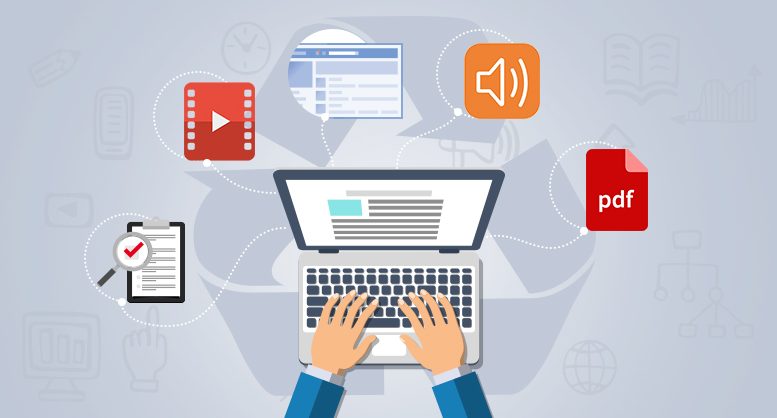“There is no such thing as a new idea. It is impossible. We simply take a lot of old ideas and put them into a sort of mental kaleidoscope. We give them a turn and they make new and curious combinations. We keep on turning and making new combinations indefinitely; but they are the same old pieces of coloured glass that have been in use through all the ages.”
–Mark Twain
I am not sure who coined the term ‘Repurposing of content’ in the digital marketing context. Most likely, they were a fan of Mark Twain as there seems to be an uncanny connection between Mark Twain’s above quote, and content repurposing.
I recently trained a group of young digital marketing professionals from the marketing team of a leading organisation on the benefits of content repurposing. And the first thing I shared with them was how do we define this oft-misunderstood term.
Lately, this term has gained traction among the digital marketing fraternity in addition to a couple of other ‘RE’ terms such as re-marketing, re-targeting, and re-engaging. More often than not, people associate repurposing with tweaking content to fit different social media platforms. However, this is only partially correct.
The definition must answer two basic questions. First, what is repurposing? and the second, what is the purpose for which is it being undertaken? My definition is Repurposing = PSC3
- Construction: Repurposing takes place when we change the Construction of the content. Examples
-
- Shorten it – Create a one-pager summary from a case study. Write a blog post based on a report
- Expand it – Use a social media post to write a blog
- Make a summary – Executive summary of a report
- Add pictures/infographics to make it more interesting
- Container: The second method to repurpose content is to change it to make it suitable for the Container. Imagine a liquid – say orange juice. We all have studied in school that all liquids take the shape of a container. Right! However, try adjusting the contents of a 5-liter jar of orange juice inside a 250 ml bottle. One cannot put the entire orange juice inside a cup, which has the capacity limitation of 250 ml of liquid. One will need to modify the original state of the orange juice – heat it, convert it into a concentrate, and only then put it in the container. Consider various platforms such as a website, social media such as FB, Twitter, LinkedIn, blog sites such as medium, and podcasts as containers. We will need to modify the content to suit the requirement set by the containers. Twitter has a character limit, LinkedIn users prefer a different type of content than someone on YouTube. Therefore, the content needs to change form as per the requirement of the platform/container.
- Current: The third C of content repurposing is when we update or refresh it to make it ‘current’. Examples are renewing an old report with new research, updating an old blog with a fresh perspective, especially in the light of the latest developments, a rolling research-based trend report which is updated basis new information from customers.
- Personas: The ‘P’ of repurposing is when content customization is undertaken to appeal to different personas. It is a basic communications tenet that all content should be created keeping the target audience at the center. More often than not, companies and marketers need to reach out to more than one set of the target audience to market their products and services. To understand their target audiences better, marketers create different personas. These are fictitious characters created as a proxy to different target audiences based on common behavior, demographics, etc. The same content may not work for different personas. Let’s take the case of a B2B company selling high-value software services. The initiator or decision-maker may be the CTO/CIO but the person who is assigned to do the research and put together a report may be the Assistant Manager IT manager. The researcher will look for a detailed white paper or a report but a much more concise content piece or a podcast may interest the CTO.
- Stage: The customers may be at different stages of the buying process. For brevity, we will consider a 3-stage process – Awareness, Consideration, and Decision stages. The type of information that the prospective customers will seek at each of these stages is different. Therefore, the content needs to be customised according to each stage.
All these five elements – the three Cs, P, and S come together to define the Repurposing of content. If the repurposing is done keeping in mind the above five elements, we can expect that the content will be effective and have a longer shelf life.
The views and opinions published here belong to the author and do not necessarily reflect the views and opinions of the publisher.



Be the first to comment on "The purpose of content repurposing"